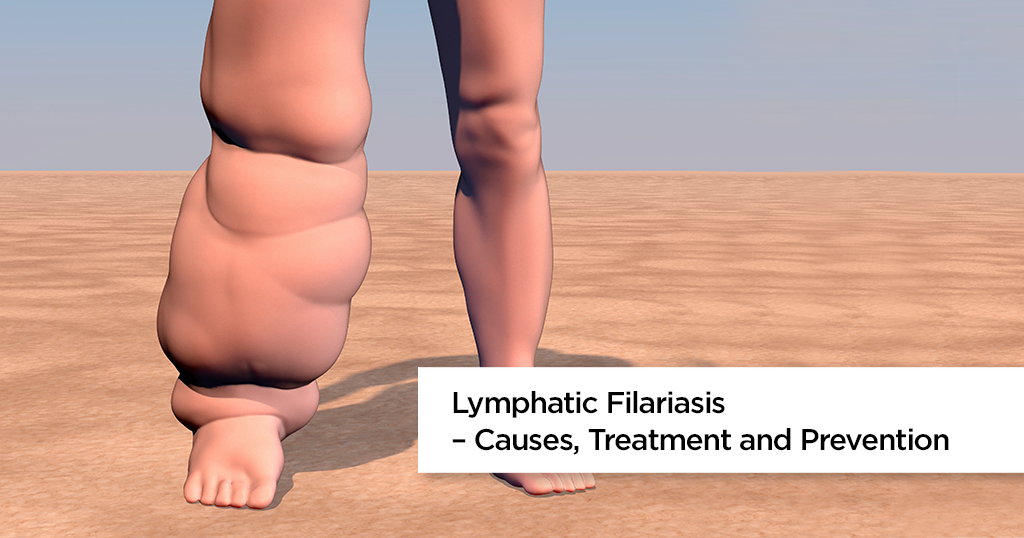Lymphatic filariasis, also commonly called, ‘elephantiasis’, is a painful and an overwhelmingly disfiguring disease. In India, majority (almost 99 percent) of infections is transmitted from mosquitoes spreading a type of worm through its bite. It is also called lymphatic filariasis as it attacks the lymphatic vessels.
Lymphatic vessels are present all over the body and help in draining unwanted substances through a fluid called lymph which is then excreted by the body. The lymph system maintains the fluid balance of the body and fights infection.
Filariasis affects many people globally every year. It is a major public health problem in all parts of India except the North and North-East. It is also widespread in China, Indonesia, Africa, Latin America and the Carribean Islands.
Causes of Lymphatic Filariasis
- Lymphatic Filariasis spreads from one individual to another by mosquito bites. When a mosquito bites an individual with lymphatic filariasis, microscopic worms circulating in that individual’s blood enter and infect the mosquito. When this infected mosquito bites another healthy individual, the microscopic worms (microfilariae) passes through the skin and travels to this individual’s lymph vessels. These microscopic worms grow into adults in the lymph vessels. The adult worm lives for close 5 – 7 years. These adult worms mate to yet again release millions of microscopic worms into the blood. Hence, people with microscopic worms in their blood can give the infection to other people through mosquitoes.
- Filariasis is spread by mosquitoes which bite at night between dusk and dawn.
- Urbanization, poverty, poor sanitation and migration of people are the reasons responsible in spreading the disease.
- Men are affected more than women probably as they are out of the house for longer and have more exposed skin than women.
Symptoms and signs of lymphatic filariasis
- In most cases, there are no symptoms initially when the infection is transmitted. The person may be unaware that he has the disease.
- In the acute stage that lasts from a few months to a few years, fever, inflammation of the lymph vessels (lymphangitis), swelling of the lymph nodes (lymphadenitis) and significant swelling of the arms, legs and breasts may be seen. Sometimes the male genitals become swollen, this is called hydrocele where the scrotum is swollen and painful. The enlarged scrotum prevents the person from wearing underwear as it will increase the pressure.
- In the chronic stage which is seen after a decade of the initial attack, the parts of the body become swollen as the lymph vessels are unable to drain the lymph which accumulates in the tissues, leading to huge limbs called elephantiasis. Another sign is lymph excreted in the urine called chyluria.
- There is poor immunity as the affected person’s cannot fight infections hence they are more prone to bacterial infections of skin and lymph vessels.
- In a condition called occult filariasis, there is a hypersensitivity reaction (allergic reaction) to the filarial parasites. This leads to an illness called tropical pulmonary eosinophilia.
Diagnosis of Lymphatic Filariasis
History of living in a place endemic to filariasis should lead to the suspicion of Lymphatic filariasis. It requires many mosquito bites over a long period of time to acquire filariasis; hence tourists are not susceptible.
Investigations to diagnose Lymphatic Filariasis
Blood for testing is collected at night as the parasites are present in great numbers in blood in the night and only few are seen during the day. If the microfilarie are seen in the blood, the diagnosis is confirmed.
Treatment of Lymphatic Filariasis
The drug of choice for filariasis is called diethylcarbamazine citrate (DEC). This drug will not kill the adult worms in a person’s body but prevent the spread of infection to another person. It does not cure elephantiasis and lymphoedema (swelling in a part of the body as a result of fluid build-up) but kills the microfilariae in the blood.
DEC is given once a year through a mass drug approved (MDA) system free of cost to people in endemic areas. The dosage varies for children and adults. People having the microfilariae in the blood will experience fever, vomiting, rash, itching, headache and body ache. Pregnant women should not take the drug. However, it can be taken after delivery.
Treatment for hydrocele is surgery to remove the fluid and relieve the pain.
If elephantiasis occurs, the person must be taught the importance of keeping the affected part clean and applying an antibiotic ointment if any small cut develops as the infection may spread if not treated promptly.
Prevention of Lymphatic Filariasis
- Close all windows before dusk up to dawn to prevent mosquitoes from entering the house.
- Use mosquito nets while sleeping, alternatively use mosquito repellent cream on all exposed areas.
- Don’t keep stagnant water in the surroundings as these pools of water are mosquito breeding grounds.
- Avoid exposing arms and legs while in affected places, especially between dusk and dawn. Wear clothes with long sleeves, full length pants and socks for adequate protection.

